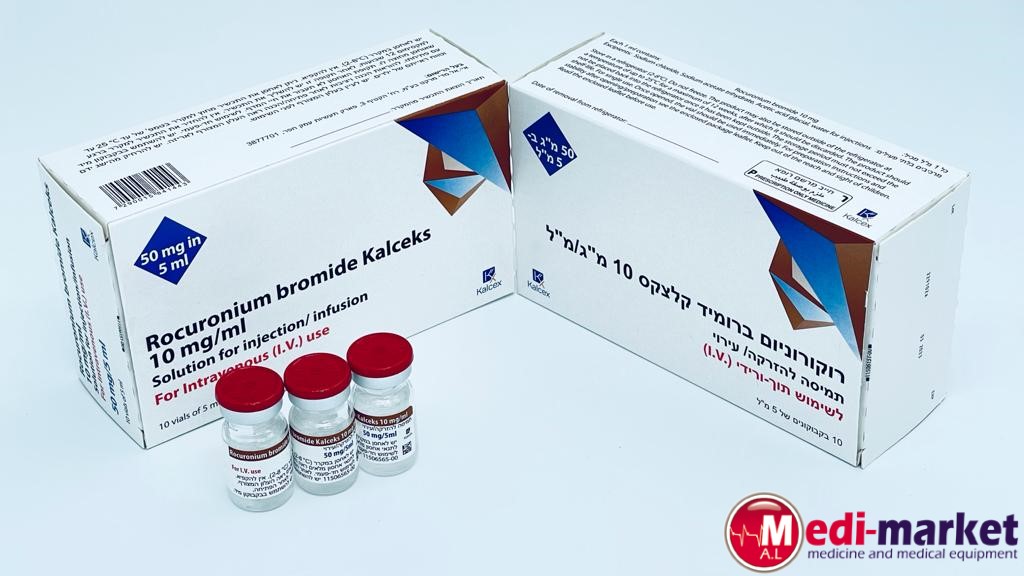Quest for the right Drug

רוקורוניום ברומיד קלצקס 10 מ"ג/מ"ל ROCURONIUM BROMIDE KALCEKS 10 MG/ML (ROCURONIUM BROMIDE)
תרופה במרשם
תרופה בסל
נרקוטיקה
ציטוטוקסיקה
צורת מתן:
תוך-ורידי : I.V
צורת מינון:
תמיסה להזרקהאינפוזיה : SOLUTION FOR INJECTION / INFUSION
עלון לרופא
מינוניםPosology התוויות
Indications תופעות לוואי
Adverse reactions התוויות נגד
Contraindications אינטראקציות
Interactions מינון יתר
Overdose הריון/הנקה
Pregnancy & Lactation אוכלוסיות מיוחדות
Special populations תכונות פרמקולוגיות
Pharmacological properties מידע רוקחי
Pharmaceutical particulars אזהרת שימוש
Special Warning עלון לרופא
Physicians Leaflet
Special Warning : אזהרת שימוש
4.4 Special warnings and precautions for use Since Rocuronium bromide Kalceks causes paralysis of the respiratory muscles, ventilatory support is mandatory for patients treated with this drug until adequate spontaneous respiration is restored. As with all neuromuscular blocking agents, it is important to anticipate intubation difficulties, particularly when used as part of a rapid sequence induction technique. As with other neuromuscular blocking agents, residual neuromuscular blockade has been reported for rocuronium bromide . In order to prevent complications resulting from residual neuromuscular blockade, it is recommended to extubate only after the patient has recovered sufficiently from neuromuscular block. Geriatric patients (65 years or older) may be at increased risk for residual neuromuscular block. Other factors which could cause residual neuromuscular blockade after extubation in the post-operative phase (such as drug interactions or patient condition) should also be considered. If not used as part of standard clinical practice, the use of a reversal agent (such as sugammadex or acetylcholinesterase inhibitors) should be considered, especially in those cases where residual neuromuscular blockade is more likely to occur. High rates of cross-sensitivity between neuromuscular blocking agents have been reported. Therefore, where possible, before administering Rocuronium bromide Kalceks , hypersensitivity to other neuromuscular blocking agents should be excluded. Rocuronium bromide Kalceks should only be used when absolutely essential in susceptible patients. Patients who experience a hypersensitivity reaction under general anaesthesia should be tested subsequently for hypersensitivity to other neuromuscular blockers. Rocuronium may increase the heart rate. In general, following long term use of neuromuscular blocking agents in the ICU, prolonged paralysis and/or skeletal muscle weakness has been noted. In order to help preclude possible prolongation of neuromuscular block and/or overdosage it is strongly recommended that neuromuscular transmission is monitored throughout the use of neuromuscular blocking agents. In addition, patients should receive adequate analgesia and sedation. Furthermore, neuromuscular blocking agents should be titrated to effect in the individual patients by or under supervision of experienced clinicians who are familiar with their actions and with appropriate neuromuscular monitoring techniques. Myopathy after long term administration of other non-depolarising neuromuscular blocking agents in the ICU in combination with corticosteroid therapy has been reported regularly. Therefore, for patients receiving both neuromuscular blocking agents and corticosteroids, the period of use of the neuromuscular blocking agent should be limited as much as possible. If suxamethonium is used for intubation, the administration of Rocuronium bromide Kalceks should be delayed until the patient has clinically recovered from the neuromuscular block induced by suxamethonium. Because rocuronium bromide is always used with other drugs and because of the risk of malignant hyperthermia during anesthesia, even in the absence of known triggering factors, physicians should be aware of the early symptoms, confirmatory diagnosis and treatment of malignant hyperthermia prior to the start of anesthesia. Animal studies have shown that rocuronium bromide is not a triggering factor for malignant hyperthermia. Rare cases of malignant hyperthermia with Rocuronium bromide Kalceks have been observed thru post-marketing surveillance; however, the causal association has not been proven. The following conditions may influence the pharmacokinetics and/or pharmacodynamics of Rocuronium bromide Kalceks : Hepatic and/or biliary tract disease and renal failure Because rocuronium is excreted in urine and bile, it should be used with caution in patients with clinically significant hepatic and/or biliary diseases and/or renal failure. In these patient groups prolongation of action has been observed with doses of 0.6 mg/kg rocuronium bromide. Prolonged circulation time Conditions associated with prolonged circulation time such as cardiovascular disease, old age and oedematous state resulting in an increased volume of distribution, may contribute to a slower onset of action. The duration of action may also be prolonged due to a reduced plasma clearance. Neuromuscular disease Like other neuromuscular blocking agents, Rocuronium bromide Kalceks should be used with extreme caution in patients with a neuromuscular disease or after poliomyelitis since the response to neuromuscular blocking agents may be considerably altered in these cases. The magnitude and direction of this alteration may vary widely. In patients with myasthenia gravis or with the myasthenic (Eaton- Lambert) syndrome, small doses of Rocuronium bromide Kalceks may have profound effects and Rocuronium bromide Kalceks should be titrated to the response. Hypothermia In surgery under hypothermic conditions, the neuromuscular blocking effect of Rocuronium bromide Kalceks is increased and the duration prolonged. Obesity Like other neuromuscular blocking agents, Rocuronium bromide Kalceks may exhibit a prolonged duration and a prolonged spontaneous recovery in obese patients when the administered doses are calculated on actual body weight. Burns Patients with burns are known to develop resistance to non-depolarising neuromuscular blocking agents. It is recommended that the dose is titrated to response. Conditions which may increase the effects of Rocuronium bromide Kalceks Hypokalaemia (e.g. after severe vomiting, diarrhoea and diuretic therapy), hypermagnesaemia, hypocalcaemia (after massive transfusions), hypoproteinaemia, dehydration, acidosis, hypercapnia, cachexia. Severe electrolyte disturbances, altered blood pH or dehydration should therefore be corrected when possible. Sodium This medicine contains less than 1 mmol sodium (23 mg) per vial, that is to say essentially ‘sodium-free’.
Effects on Driving
4.7 Effects on ability to drive and use machines Since Rocuronium bromide Kalceks is used as an adjunct to general anaesthesia, the usual precautionary measures after a general anaesthesia should be taken for ambulatory patients.

שימוש לפי פנקס קופ''ח כללית 1994
לא צוין
תאריך הכללה מקורי בסל
לא צוין
הגבלות
לא צוין
מידע נוסף
